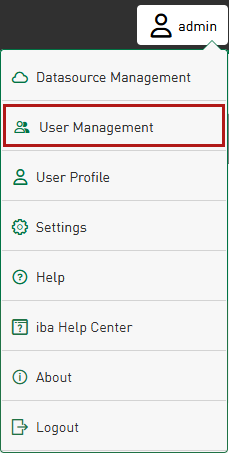In the User Management, you set up the various user accounts, organize them into groups and define the respective permissions. You can access the user management via the administration menu.
A difference is made between local users/groups and domain users/domain groups.
|
Local Users/ Local Groups |
The access information is only valid for logging in to ibaDaVIS and is set up and managed by the admin user. |
|
Domain Users/ Domain Groups |
The admin user registers the domain groups or domain users in the ibaDaVIS user administration. Thus, the access information for the domain can also be used to log in to ibaDaVIS. |
You can assign different permissions to the users and groups. A user can be a member of one or more groups. The groups can have different permissions. The user-specific permissions and the permissions of the groups complement each other to create effective rights for the user.
When the computer where ibaDaVIS runs is joined to a domain, it is possible to add users and user groups of that domain. Please consider, that the integration of a domain group also provides access to ibaDaVIS to all domain users. If an individual domain user is integrated even though their domain group has already been set up, they can be assigned special and extended authorizations for their domain group.
Note |
|
|---|---|
|
ibaDaVIS uses a Microsoft API for the connection to the Active Directory, which supports Active Directory Domain Services (AD DS), Active Directory Lightweight Directory Services (AD LDS) and Machine SAM (MSAM). LDAP is not supported. |
|
Note |
|
|---|---|
|
In most scenarios, ibaDaVIS runs under the system account. If the system account is very restricted in terms of domain rights, it is recommended to use the ibaDaVIS service under a dedicated account with domain access. |
|
